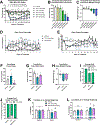Tirzepatide suppresses palatable food intake by selectively reducing preference for fat in rodents
- PMID: 36054312
- PMCID: PMC10362946
- DOI: 10.1111/dom.14843
Tirzepatide suppresses palatable food intake by selectively reducing preference for fat in rodents
Abstract
Aim: To investigate the role of glucose-dependent insulinotropic polypeptide receptor (GIPR) agonists alone or combined with glucagon-like peptide-1 receptor (GLP-1R) agonists to regulate palatable food intake and the role of specific macronutrients in these preferences.
Methods: To understand this regulation, we treated mice and rats on several choice diet paradigms of chow and a palatable food option with individual or dual GIPR and GLP-1R agonists.
Results: In mice, the dual agonist tirzepatide suppressed total caloric intake, while promoting the intake of chow over a high fat/sucrose diet. Surprisingly, GIPR agonism alone did not alter food choice. The food intake shift observed with tirzepatide in wild-type mice was completely absent in GLP-1R knockout mice, suggesting that GIPR signalling does not regulate food preference. Tirzepatide also selectively suppressed the intake of palatable food but not chow in a rat two-diet choice model. This suppression was specific to lipids, as GLP-1R agonist and dual agonist treatment in rats on a choice paradigm assessing individual palatable macronutrients robustly inhibited the intake of Crisco (lipid) without decreasing the intake of a sucrose (carbohydrate) solution.
Conclusions: Decreasing preference for high-caloric, high-fat foods is a powerful action of GLP-1R and dual GIPR/GLP-1R agonist therapeutics, which may contribute to the weight loss success of these drugs.
Keywords: diet preference; dual GIP/GLP-1 receptor agonists; food intake; obesity; tirzepatide.
© 2022 John Wiley & Sons Ltd.
Conflict of interest statement
Declaration of Interests
No other potential conflicts of interest relevant to this article were reported.
Figures





Similar articles
-
Specific loss of GIPR signaling in GABAergic neurons enhances GLP-1R agonist-induced body weight loss.Mol Metab. 2025 May;95:102074. doi: 10.1016/j.molmet.2024.102074. Epub 2024 Nov 26. Mol Metab. 2025. PMID: 39612941 Free PMC article.
-
Loss of GIPR in LEPR cells impairs glucose control by GIP and GIP:GLP-1 co-agonism without affecting body weight and food intake in mice.Mol Metab. 2024 May;83:101915. doi: 10.1016/j.molmet.2024.101915. Epub 2024 Mar 14. Mol Metab. 2024. PMID: 38492844 Free PMC article.
-
Optimized GIP analogs promote body weight lowering in mice through GIPR agonism not antagonism.Mol Metab. 2019 Feb;20:51-62. doi: 10.1016/j.molmet.2018.12.001. Epub 2018 Dec 5. Mol Metab. 2019. PMID: 30578168 Free PMC article.
-
GLP-1/GIP analogs: potential impact in the landscape of obesity pharmacotherapy.Expert Opin Pharmacother. 2023 Apr;24(5):587-597. doi: 10.1080/14656566.2023.2192865. Epub 2023 Mar 28. Expert Opin Pharmacother. 2023. PMID: 36927378 Review.
-
Obesity pharmacotherapy: incretin action in the central nervous system.Trends Pharmacol Sci. 2023 Jan;44(1):50-63. doi: 10.1016/j.tips.2022.11.001. Epub 2022 Nov 30. Trends Pharmacol Sci. 2023. PMID: 36462999 Review.
Cited by
-
Mechanosensation of the heart and gut elicits hypometabolism and vigilance in mice.Nat Metab. 2025 Feb;7(2):263-275. doi: 10.1038/s42255-024-01205-6. Epub 2025 Jan 17. Nat Metab. 2025. PMID: 39824919 Free PMC article.
-
Tirzepatide against obesity and insulin-resistance: pathophysiological aspects and clinical evidence.Front Endocrinol (Lausanne). 2024 Jun 24;15:1402583. doi: 10.3389/fendo.2024.1402583. eCollection 2024. Front Endocrinol (Lausanne). 2024. PMID: 38978621 Free PMC article. Review.
-
GLP1-GIP receptor co-agonists: a promising evolution in the treatment of type 2 diabetes.Acta Diabetol. 2024 Aug;61(8):941-950. doi: 10.1007/s00592-024-02300-6. Epub 2024 Jun 3. Acta Diabetol. 2024. PMID: 38831203 Free PMC article. Review.
-
Transforming obesity: The advancement of multi-receptor drugs.Cell. 2024 Jul 25;187(15):3829-3853. doi: 10.1016/j.cell.2024.06.003. Cell. 2024. PMID: 39059360 Free PMC article. Review.
-
Female obesity: clinical and psychological assessment toward the best treatment.Front Endocrinol (Lausanne). 2024 May 3;15:1349794. doi: 10.3389/fendo.2024.1349794. eCollection 2024. Front Endocrinol (Lausanne). 2024. PMID: 38765954 Free PMC article. Review.
References
-
- Drucker DJ. Mechanisms of Action and Therapeutic Application of Glucagon-like Peptide-1. Cell metabolism. 2018;27(4):740–756. - PubMed
-
- Global diabetes therapeutic market has grown sixfold in last 20 years. GlobalData Pharma Intelligence Center 2021.

